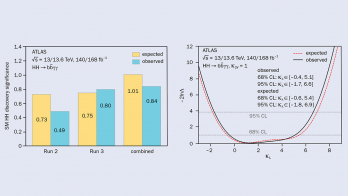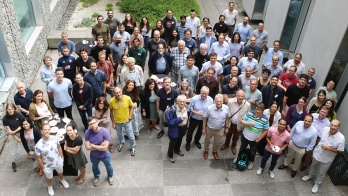
Ever since the W boson was discovered at CERN’s SppS four decades ago, successive collider experiments have pinned down its mass at increasing levels of precision. Unlike the fermion masses, the W mass is a clear prediction of the Standard Model (SM). At lowest order in electroweak theory, it depends solely on the mass of the Z boson and the value of the weak mixing angle. But higher-order corrections introduce an additional dependence on the gauge-boson couplings and the masses of other SM particles, in particular the heavy top quark and Higgs boson. With the precision of electroweak calculations now exceeding that of direct measurements, better knowledge of the measured W mass provides a vital test of the SM’s consistency.
The immediate reaction was silence
Chris Hays
A new measurement by the CDF collaboration based on data from the former Tevatron collider at Fermilab throws a curveball into this picture. Published today in Science, the CDF W-mass measurement – the most precise to date – stands 7σ from the SM prediction, upsetting decades of steady convergence between experiment and theory.
“I would say the immediate reaction was silence,” says Chris Hays, one of the CDF analysis leads, of the moment the measurement was unblinded on 19 November 2020. “Then there was some discussion to ensure the unblinding worked, i.e. that the value was correct, and to decide what would be the next steps.”
Long slog
CDF physicists have been measuring the mass of the W boson for more than 30 years via its decays to a lepton and a neutrino. In 2012, shortly after the Tevatron shut down, CDF published a W mass of 80,387 ± 12 (stat) ± 15 (syst) MeV based on 2.2 fb-1 of data, which significantly exceeded the precision of all previous measurements at that time combined. After 10 years of careful analysis and scrutiny of the full Tevatron dataset (8.8 fb-1, corresponding to about 4.2 million W-boson candidates), and taking into account an improved understanding of the detector and advances in the theoretical and experimental understanding of the W’s interactions with other particles, the new CDF result is twice as precise: 80,433.5 ± 6.4 (stat) ± 6.9 (syst) MeV.
In addition to the four-fold increase in statistics, the measurement benefits from a better understanding of systematic uncertainties. One significant change concerns the proton/antiproton parton distribution functions (PDFs), where the addition of LHC data to the PDF fits has reduced the uncertainty from 10 MeV to 3.9 MeV while also slightly raising the central value of the 2012 result.

“The 2012 and 2022 CDF values are in agreement at the level of two sigma accounting for the fact that approximately 25% of the events are in common, so the internal tension is not so significant,” explains CDF collaborator Mark Lancaster, who was an internal reviewer for the result. “But the tension with other results — particularly ATLAS at 80,370 ± 19 MeV and the SM at 80,357 ± 6 MeV — is significant. Many people from the LHC, Tevatron and theory community are presently working together to combine the results from the Tevatron, LHC and LEP and understand the correlations between them, e.g. in the PDFs and some of the higher order QCD and QED effects.”
It’s now up to theorists and other experiments to follow up on the CDF result, comments CDF co-spokesperson David Toback. “If the difference between the experimental and expected value is due to some kind of new particle or subatomic interaction, which is one of the possibilities, there’s a good chance it’s something that could be discovered in future experiments,” he says.
Cross checks
Results from the LHC experiments are crucial to enable a deeper understanding. One of the challenges in measuring the W mass in high-rate proton-proton collisions at the LHC is event “pile-up”, which makes it hard to reconstruct the missing transverse energy from neutrinos. The higher collision energy at the LHC also means W bosons are produced with larger transverse momenta with respect to the beam axis, which needs to be properly modeled in order to measure the W boson mass precisely.
It takes years to build up the knowledge of the detector necessary to be able to address all the issues satisfactorily
Florencia Canelli
The ATLAS collaboration published the first high-precision measurement of the W mass at the LHC in 2018 based on data collected at a centre-of-mass energy of 7 TeV, and is currently working on new measurements. In September, based on 2016 data, LHCb published its first measurement of the W mass: 80,354 ± 32 MeV, and estimates that an uncertainty of 20 MeV or less is achievable with existing data. CMS is also proceeding with analyses that should soon see its first public result. “It’s an important measurement of our physics programme,” says CMS physics co-cordinator Florencia Canelli. “As the CDF result shows, precision physics can be a challenging and lengthy process: it takes a very long time to understand all aspects of the data to the level of precision required for a competitive W-mass measurement, and it takes years to build up the knowledge of the detector necessary to be able to address all the issues satisfactorily.”
The CDF result reiterates the central importance of precision measurements in the search for new physics, describe Claudio Campagnari (UC Santa Barbara) and Martijn Mulders (CERN) in a Perspective article accompanying the CDF paper. They point to the increased precision that will be available at the High-Luminosity LHC and the capabilities of future facilities such as the proposed Future Circular Collider, the e+e– mode of which “would offer the best prospects for an improved W-boson mass measurement, with a projected sensitivity of 7 ppm”. Such a measurement would also demand the SM electroweak calculations be performed at higher orders, a challenge firmly in the sights of the theory community.
Following the 2012 discovery of the Higgs boson, it is not easy to tweak the SM parameters without ruining the excellent agreement with numerous measurements. Furthermore, unlike calculations such as that of the muon anomalous magnetic moment, which relies on significant input from QCD, the prediction of the W mass relies mostly on “cleaner” electroweak computations. Surveying possible new physics that could push the W mass to higher values than expected, the CDF paper points to hypotheses that offer a deeper understanding of the Higgs field, from which the SM particles get their masses. These include supersymmetry and Higgs-boson compositeness, both of which include a potential source of dark matter.
“Supersymmetry could make a significant change to the SM prediction of the W mass, although it seems difficult to explain as big an effect as seen experimentally,” says theorist John Ellis. “But one prediction I can make with confidence is a tsunami of arXiv papers in the weeks ahead.”
Further reading
CDF Collaboration 2022 Science 376 170.








